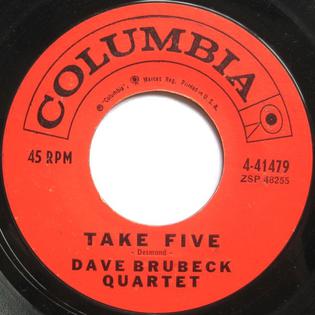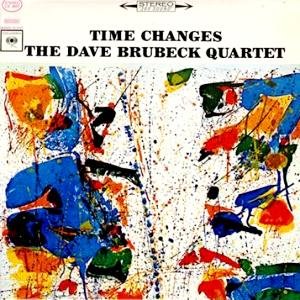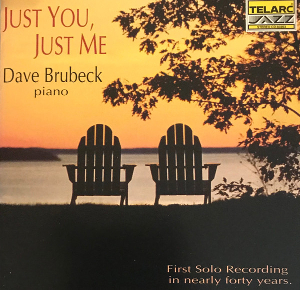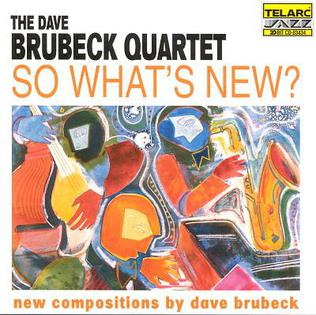
David Warren Brubeck was an American jazz pianist and composer. Often regarded as a foremost exponent of cool jazz, Brubeck's work is characterized by unusual time signatures and superimposing contrasting rhythms, meters, and tonalities.

Joseph Albert Morello was an American jazz drummer best known for serving as the drummer for pianist Dave Brubeck, as part of the Dave Brubeck Quartet, from 1957 to 1972, including during the quartet's "classic lineup" from 1958 to 1968, which also included alto saxophonist Paul Desmond and bassist Eugene Wright. Morello's facility for playing unusual time signatures and rhythms enabled that group to record a series of albums that explored them. The most notable of these was the first in the series, the 1959 album Time Out, which contained the hit songs "Take Five" and "Blue Rondo à la Turk". In fact, "Take Five", the album's biggest hit was specifically written by Desmond as a way to showcase Morello's ability to play in 5
4 time.

At Carnegie Hall is a jazz live album by the Dave Brubeck Quartet. It was recorded at the famed Carnegie Hall in New York City on Friday, February 22, 1963. Critic Thom Jurek described it as "one of the great live jazz albums of the 1960s". Critic Jim Santella wrote, "This is timeless music from a classic ensemble. Goosebumps are guaranteed."

"Take Five" is a jazz standard composed by Paul Desmond. It was first recorded in 1959 and is the third track on Time Out by the Dave Brubeck Quartet. Frequently covered by a variety of artists, the track is the biggest-selling jazz song of all time and a Grammy Hall of Fame inductee.
"Blue Rondo à la Turk" is a jazz standard composition by Dave Brubeck. It appeared on the album Time Out in 1959. It is written in 9
8 time, with one side theme in 4
4, and the choice of rhythm was inspired by the Turkish aksak time signatures. It was originally recorded by the Dave Brubeck Quartet with Dave Brubeck on piano, Paul Desmond on alto saxophone, Eugene Wright on bass, and Joe Morello on drums.

Jazz Goes to College is a 1954 album documenting the North American college tour of the Dave Brubeck Quartet. It was Dave Brubeck's first album for Columbia Records. He was joined by alto saxophonist Paul Desmond, double bassist Bob Bates, and drummer Joe Dodge. The album was re-released on CD and cassette in the Columbia Jazz Masterpieces series in 1989 and on CD by Sony International in 2000.

Time Further Out is a jazz studio album by the Dave Brubeck Quartet released by Columbia Records in November 1961. It features the "classic" lineup of the quartet: pianist and leader Dave Brubeck, alto saxophonist Paul Desmond, bassist Eugene Wright, and drummer Joe Morello. The album was recorded by engineer Fred Plaut and produced by Teo Macero.

Paper Moon was recorded by the Dave Brubeck Quartet at Coast Recorders in San Francisco, California. The record was released in September 1981 by Concord Jazz, a subsidiary of Concord Records. It was produced by Russell Gloyd and engineered by Ron Davis and Phil Edwards. On this recording, pianist Dave Brubeck is accompanied by his son Chris Brubeck on the bass and bass trombone, with Jerry Bergonzi on tenor sax and Randy Jones on the drums. Paper Moon is Brubeck's third of three Concord recordings featuring this permutation of the Dave Brubeck Quartet; jazz commentator Scott Yanow referred to the album as the "most rewarding of the trio".

Time Changes is a 1964 album by The Dave Brubeck Quartet, based upon the use of time signatures that were unusual in jazz music.

The Great Concerts is a jazz live album by The Dave Brubeck Quartet. It was originally released on LP and CD under the series Columbia Jazz Masterpieces, in 1988. Then, it was re-released in 1998 and again in 2009. It includes live recordings from 1958 and 1963. The pieces were produced by associated producers: the first six tracks were produced by Teo Macero and Mike Berniker; track 7 and 8 by Berniker and Cal Lampley.

Time In is a 1966 studio album by Dave Brubeck, the last of Brubeck's 'Time' series.

"In Your Own Sweet Way" is a 1955 jazz standard, and one of the most famous compositions by Dave Brubeck. It was written around 1952, but its copyright notice was dated 1955. Brubeck's wife Iola, for whom the song was written, later wrote a lyric for the song, which led to singers such as Carmen McRae recording it. "In Your Own Sweet Way" was first released on Brubeck's 1956 studio album Brubeck Plays Brubeck; an earlier live recording is known.

Just You, Just Me is a 1994 album by Dave Brubeck. This album is the 3rd of Brubeck's solo works preceded by Brubeck Plays Brubeck and Plays and Plays and.... There was a 37-year gap between "Brubeck Plays and Plays" and this album with Brubeck focusing on working with his quartet during that time. Brubeck writes that for this album, "...I prefer to record in the same way as I play at home..." with all of the songs on this album being first takes with no advanced editing. The exception to this is "I Understand" of which Brubeck did three takes playing each in different ways.

Supernova is a studio album by The Gonzalo Rubalcaba Trio released by Blue Note Records on July 17, 2001. The trio consisted of Gonzalo Rubalcaba on piano, bassist Carlos Henriguez, and drummer Ignacio Berroa. It peaked at number 25 in the Billboard Top Jazz Albums chart.

Countdown—Time in Outer Space is a studio album released by the Dave Brubeck Quartet in 1962 on Columbia LP record CS 8575 (stereo) and CL 1775 (mono). The front cover features the 1959 painting Orange and Black Wall by Franz Kline. In Australia the album appeared on the Coronet label. It was re-released, for the first time in digital format, in 2004 as part of a compact disc collection titled Dave Brubeck: For All Time. It was again released as part of the box set The Dave Brubeck Quartet: the Columbia Studio Albums Collection 1955-1966. Both CD re-releases feature a bonus track titled "Fatha".

The Last Set at Newport is a 1971 live album by Dave Brubeck and his quartet recorded at the 1971 Newport Jazz Festival, shortly before a riot ensued. The album peaked at 16 on the Billboard Top Jazz Charts.

Brandenburg Gate: Revisited is a studio album by The Dave Brubeck Quartet accompanied by an orchestra arranged by Howard Brubeck.

So What's New? is a 1998 studio album by pianist Dave Brubeck and his quartet.

The Crossing is 2001 studio album by pianist Dave Brubeck and his quartet.

Jazz Impressions of Eurasia is a studio album by pianist Dave Brubeck and his quartet recorded after, and inspired by, their 1958 world tour sponsored by the American state department during which they played 80 concerts in 14 countries, including Turkey, Iran, Iraq, India, Pakistan, and Afghanistan, over three months. In the liner notes to the album, Brubeck notes that "These sketches of Eurasia have been developed from random musical phrases I jotted down in my notebook as we chugged across the fields of Europe, or skimmed across the deserts of Asia, or walked in the alleyways of an ancient bazaar. ... I tried to create an impression of a particular locale by using some of the elements of their folk music within the jazz idiom." The album was recorded in July and August 1958 at the Columbia 30th St. Studios in New York.


















